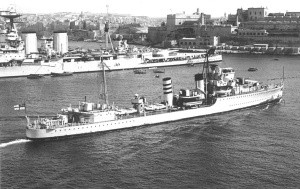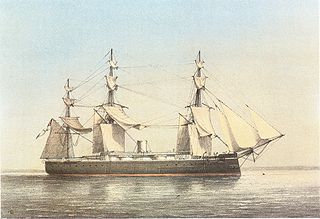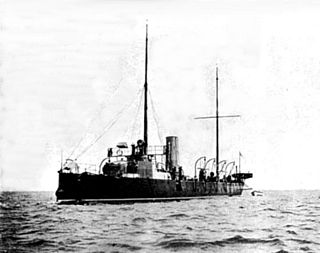
An ironclad was a steam-propelled warship protected by steel or iron armor constructed from 1859 to the early 1890s. The ironclad was developed as a result of the vulnerability of wooden warships to explosive or incendiary shells. The first ironclad battleship, Gloire, was launched by the French Navy in November 1859, narrowly preempting the British Royal Navy. However, Britain built the first completely iron-hulled warships.

The seventh HMS Enterprise of the Royal Navy was an armoured sloop launched in 1864 at Deptford Dockyard. Originally laid down as a wooden screw sloop of the Camelion class, she was redesigned by Edward Reed and completed as a central battery ironclad. The ship spent the bulk of her career assigned to the Mediterranean Fleet before returning to England in 1871 where she was paid off. Enterprise was sold for scrap in 1885.

HMS Inglefield was an I-class destroyer leader built for the Royal Navy that served during World War II. She was the navy's last purpose-built flotilla leader. She was named after the 19th century Admiral Sir Edward Augustus Inglefield (1820–1894), and is so far the only warship to carry the name of that seafaring family. In May 1940, her pennant number was changed to I02.

HMS Invincible was a Royal Navy Audacious-class ironclad battleship. She was built at the Napier shipyard and completed in 1870. Completed just 10 years after HMS Warrior, she still carried sails as well as a steam engine.

HMS Iron Duke was the last of four Audacious-class central battery ironclads built for the Royal Navy in the late 1860s. Completed in 1871, the ship was briefly assigned to the Reserve Fleet as a guardship in Ireland, before she was sent out to the China Station as its flagship. Iron Duke returned four years later and resumed her duties as a guardship. She accidentally rammed and sank her sister ship, Vanguard, in a heavy fog in mid-1875 and returned to the Far East in 1878. The ship ran aground twice during this deployment and returned home in 1883. After a lengthy refit, Iron Duke was assigned to the Channel Fleet in 1885 and remained there until she again became a guardship in 1890. The ship was converted into a coal hulk a decade later and continued in that role until 1906 when she was sold for scrap and broken up.

HMS Defence was the lead ship of the Defence-class armoured frigates ordered by the Royal Navy in 1859. Upon completion in 1862 she was assigned to the Channel Fleet. The ship was paid off in 1866 to be refitted and rearmed and was briefly reassigned to the Channel Fleet when she recommissioned in 1868. Defence had short tours on the North Atlantic and Mediterranean Stations, relieving other ironclads, from 1869 to 1872 before she was refitted again from 1872 to 1874. She became guard ship on the River Shannon when she recommissioned. The ship was transferred to the Channel Fleet again in 1876 and then became guard ship on the River Mersey until 1885. Defence was placed in reserve until 1890, when she was assigned to the mechanical training school in Devonport in 1890. She was renamed Indus when the school adopted that name and served there until sold for scrap in 1935.

HMS Monarch was the first seagoing British warship to carry her guns in turrets, and the first British warship to carry guns of 12-inch (300 mm) calibre.

HMS Alexandra was a central battery ironclad of the Victorian Royal Navy, whose seagoing career was from 1877 to 1900. She spent much of her career as a flagship, and took part in operations to deter the Russian Empire's aggression against the Ottoman Empire in 1878 and the bombardment of Alexandria in 1882. She was affectionately known by her crew as Old Alex.

HMS Revenge was one of seven Royal Sovereign-class pre-dreadnought battleships built for the Royal Navy during the 1890s. She spent much of her early career as a flagship for the Flying Squadron and in the Mediterranean, Home and Channel Fleets. Revenge was assigned to the International Squadron blockading Crete during the 1897–1898 revolt there against the Ottoman Empire. She was placed in reserve upon her return home in 1900, and was then briefly assigned as a coast guard ship before she joined the Home Fleet in 1902. The ship became a gunnery training ship in 1906 until she was paid off in 1913.

HMS Bruizer was an Ardent-class destroyer which served with the Royal Navy. She was launched on 27 February 1895 by John Thornycroft at Chiswick, and was sold on 26 May 1914.
Twelve ships of the Royal Navy have borne the name HMS Mosquito, or the archaic HMS Musquito, after the tropical insect, the Mosquito:

HMS Rattlesnake was a unique design of torpedo gunboat of the Royal Navy. A result of the Russian war scare of 1885, she was designed by Nathaniel Barnaby that year and built by Laird Brothers, of Birkenhead. Quickly made obsolete by the new torpedo boat destroyers, she became an experimental submarine target ship in 1906, and was sold in 1910.

HMS Condor was the name-ship of the Royal Navy Condor-class gun-ship carrying 3 guns.

HMS Swinger was an Ariel-class composite gunboat of the Royal Navy, built at Pembroke Dockyard and launched on 7 February 1872. She served at first on the China Station and from 1883 on the Australia Station. She was hulked in 1895 sold for breaking in 1924.

HMS Basilisk was a first-class paddle sloop of the Royal Navy, built at the Woolwich Dockyard and launched on 22 August 1848.

The Ariel-class gunboat was a class of nine 4-gun composite gunboats built for the Royal Navy between 1871 and 1873. Although most were sold by 1890, one of them survived into the 1920s as a salvage vessel in private ownership. They were the first class of Royal Navy gunboat built of composite construction, that is, with iron keel, stem and stern posts, and iron framing, but planked with wood.

HMS Dragon was a Doterel-class sloop of the Royal Navy, built at Devonport Dockyard and launched on 30 May 1878. She served in the East Indies, including the Anglo-Egyptian War of 1882, and the suppression of slavery. She was sold for breaking in 1892.

The Beacon-class gunvessels were a class of composite gunboats built for the Royal Navy in the late 1860s. They were the first warships of the Royal Navy expressly designed to use the engines of an older class of ships with a different hull shape. They were generally deployed overseas to the China, East Indies, West Africa, Pacific, North America and West Indies Stations. In addition to showing the flag, the ships fought pirates and suppressed the slave trade in East and West Africa. As their engines wore out in the mid-1880s, they were mostly retired and scrapped by the end of the decade. A few survived into the early 1900s as they were modified for harbour service before being sold or scrapped.

HMS Aldenham was an escort destroyer of the Type III Hunt class. The Royal Navy ordered its construction in July 1940. Upon completion in February 1942, she was deployed to convoy escort duty. Aldenham is one of the ships credited with the sinking of the U-587 on 27 March 1942. After circumnavigating Africa, she joined the Mediterranean Fleet, escorting convoys between Alexandria, Malta and Tobruk. She took part in the Allied invasion of Sicily, landings at Salerno and Anzio, the Dodecanese campaign and Operation Dragoon before being assigned to the Adriatic campaign.



















